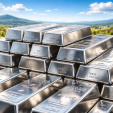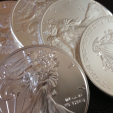Trading The Ratios And Swapping Gold For Silver
 Primary gold investors versus silver investors are not exactly alike.
Primary gold investors versus silver investors are not exactly alike.
Swapping gold for silver is a trade always worth considering, especially when the ratio blows out as wide as it is now. Portability is one obvious reason for the reverse, as long as premiums match up in the transaction. But the main advantage to this kind of swap is that silver almost always tends to cover more ground percentage-wiser and faster when it is allowed to move in a significant way.
When the price ratio of gold to silver extends out into its higher ranges, the relationship tends to be called into question. But even when the ratio approaches 30:1, or even closer to its historic ratios, the relationship should always be at the forefront of investor’s minds. However, it's not as always as simple as the paper price ratio.
A more interesting ratio is the relative buying measured primarily by U.S. mint data. Silver retail coin demand has been much stronger relative to gold, though obviously the overall dollar amounts pale in comparison.
Within the silver demand lie important ratios. We have seen a steady increase in jewelry demand (much larger than coin) relative to industrial demand, which could have the effect of pushing the market back toward shortage very quickly.
Nevertheless, one needs to consider the following as a review:
Rarity
Although it is not revealed by the price, investment-grade physical silver is actually as rare as gold; thanks to the amount that is melted, smelted, and mixed each year for a variety of consumer applications. And that is, of course, due the sheer size of the paper derivatives that mask the true value.
Supply is under constant constraint by decades of artificially low prices that have made primary silver mining the most risky of ventures. Most silver is mined as a byproduct of base metals and gold production.
Volatility
Due to the fact that most silver produced each year finds its way to a factory, the amount of silver that arrives on the retail market is only a small percentage of the total actually produced.
With such small amounts of the metal circulating, plus a massively managed and colluded price determining mechanism, silver is prone to volatile swings that occur with even the smallest shift in demand. In fact, the majority of the volatility can be blamed on the battle between speculators and bullion banks at the COMEX.
Although the volatility is short-lived, silver can move twice as much as gold in a single day, and the shiny metal is most likely to explode in price with any institutional activity.
The "Affordable" Gold
As gold heads back toward $2000 per ounce, investors will very likely experience sticker shock. Silver, on the other hand, is still affordable. It is cheap by practically any measure, and the cheapest of all assets in terms of inflation adjusted value. An investor can take delivery of more than 60 ounces of silver before owning even one ounce of gold.
Although retail investors can buy grams and half ounces of gold, the practicality of the purchase comes into question. Single grams or fractional gold is generally expensive, often costing as much as 15-20% over spot. In contrast, silver ounces, which cost less than gold grams, often trade with a much lower premium.
Fractional gold or even junk silver may not even be the best to use as temporary currency - especially in a crisis.
This is why it almost laughable to read the impression of many traders - even those who are close to the sector - who assume gold and silver in investors are always “all in” and/or have a very narrow idea of how the metals could work in a hyperinflation or currency crisis.
The fact is, the majority of physical al silver and gold investors in daring to consider the worst have realized a much more complicated and sophisticated approach to predation.
Room to Run
Today's silver price is significantly below the historical 1980 high in silver prices and well behind the historical gold to silver ratio. Silver has a 200% increase in price before it reaches a new high, and this is before calculating real inflation. Gold is a bit further along, though still comparatively undervalued.
Adjusting for inflation, silver could run as high as $160-270 per ounce before striking a new high in real dollar terms. Although both precious metals show excellent investment opportunities, silver is certainly best positioned for double-digit growth.
Trading gold for silver or vice versa makes some sense as long as the ratios are extended out to extreme ranges and that the products match up relatively speaking in terms of premium.
The truly interesting ratios lie below the surface. They can be found in the relative buying patterns, the movement of physical metal in and out of the COMEX and the relative size of the derivative positions held net short by the largest (bullion) banks.
The Investment of a Lifetime
Silver is rare, inexpensive, and a protection against inflation. It is poised for one of the best bull runs in history. Yet unlike an actual “bull run”, the move in silver will be a readjustment to reality after years of fantasy pricing.
What Do You Think?
********
For more articles like this, including thoughtful precious metals analysis beyond the mainstream propaganda and basically everything you need to know about silver, short of outlandish fiat price predictions, check out http://www.silver-coin-investor.com

















